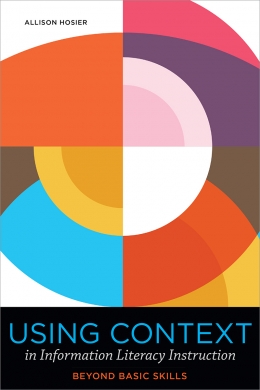Primary tabs
You don't need to be an ALA Member to purchase from the ALA Store, but you'll be asked to create an online account/profile during checkout to proceed. This Web Account is for both Members and non-Members. Note that your ALA Member discount will be applied at the final step of the checkout process.
If you are Tax-Exempt, please verify that your account is currently set up as exempt before placing your order, as our new fulfillment center will need current documentation. Learn how to verify here.
- Description
- Table of Contents
- About the author
- Reviews
Included in Choice's Top 75 Titles and Resources for Community College Libraries
Read an interview with the author now!
Hosier shows academic librarians how to use context when teaching information literacy, an approach that offers a substantive and enduring impact on students' lifelong learning.
Librarians know that information literacy is much more complex and nuanced than the basic library research skill that it's often portrayed as; in fact, as outlined by the ACRL Framework, research is a contextual activity. But the settings in which we teach often constrain our ability to take a more layered approach. This book not only shows you how to teach information literacy as something other than a basic skill, but also how to do it in whatever mode of teaching you’re most often engaged in, whether that's a credit-bearing course, a one-shot session, a tutorial, a reference desk interaction, or a library program. Taking you through each step of the research process, this book shares ideas for adding context while exploring topics such as
- how conversations about context can be integrated into lessons on common information literacy topics;
- examples of the six genres of research and suggested course outlines for each;
- ensuring that context strategies fit within the ACRL Framework;
- questions for reflection in teaching each step of the research process;
- four different roles that sources can play when researching a topic;
- helping students refine a topic that is drawing too many or too few sources;
- cultivating students to become good decision-makers for the best type of research sources to use depending on their need; and
- how to address the shortcomings of checklist tools like the CRAAP test.
Acknowledgements
Introduction: The Next Step for Information Literacy
Chapter 1: Understanding the Contextual Nature of Research
Chapter 2: Teaching the Contextual Nature of Research
Chapter 3: How Research Starts and the Importance of Context
Chapter 4: Appropriate Sources (and How to Find Them): Considering Context
Chapter 5: Evaluating Information Through a Contextual Lens
Chapter 6: The Role of Context in Using Information
Chapter 7: Creating Information with Context in Mind
Conclusion
- Appendix A: Annotated Bibliography Project
- Appendix B: Example Assessment Questions
Allison Hosier
Allison Hosier is an instructor and scholar of information literacy at the University at Albany, SUNY. Her current scholarship focuses on studying and thinking about research as an activity with important contextual implications. She writes about her work regularly on her website Studying Research .
"I found the book to be engaging and thought provoking. It is packed with ideas for teaching and engaging learners while exploring the role of context. I would recommend this book to academic librarians and others who are interested in information literacy instruction.”
— Journal of Hospital Librarianship
”An exceptionally informative, impressively organized and thoroughly 'user friendly' instructional guide that will be of immense value to library science students, novice librarians, and even more experienced library staff members and directors."
— Library Bookwatch
”Hosier’s anecdotes and reflection questions will facilitate the integration of this context into not only library courses and one-shots but also research interactions outside the classroom and online. This volume will appeal to academic librarians who want to challenge current instruction conventions or incorporate subtle changes in their (perhaps hard-won) existing information literacy instruction programs."
— Choice
”Informative, well-written ... This quick read is likely to become a handbook that an instruction librarian at any stage in their career can use to make sure they are providing their students with high quality information literacy instruction that is sure to engage learners across the spectrum. This book would make good additional reading as part of any information literacy pedagogy class and would help spur class conversations about the nature of information literacy instruction that is sorely needed in LIS curricula today."
— Journal of Education for Library and Information Science



